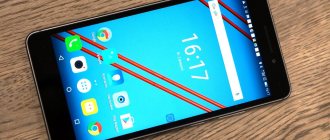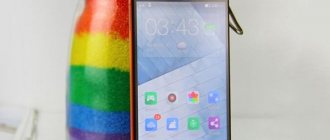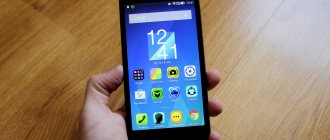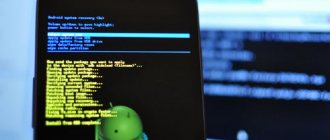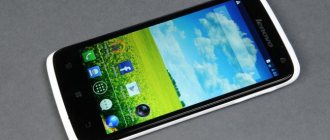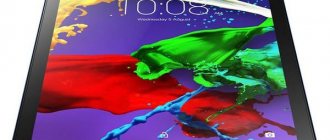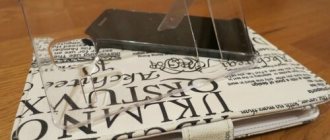We believe that there is nothing stronger in this world than children's curiosity, the desire to learn something new. The baby strives to cognize reality and fill it with his imagination. With the launch of Lenovo Phab 2 Pro, Tango technology will allow you to rediscover the world around you.
Smartphones are like children in some ways. They are always with us, we cannot imagine our life without them. But, unlike children, until recently smartphones were much less intelligent. Gadgets do not understand where they are, where they are going and do not have the slightest idea about the world around them. Smartphones cannot experience the surrounding reality through tactile sensations and expand their knowledge through “trying everything,” like babies. Tango technology promises to change everything radically.
Appearance and photos of the smartphone
Shell
Lenovo Phab2 out of the box runs Android 6.0 operating system, on top of which VibeUI is used. Lenovo's proprietary interface changes little from generation to generation; it differs from stock Android in this version primarily in its design and the presence of third-party applications (in particular, for protecting the device, cleaning up the disk, synchronizing and transferring data).
The interface has a separate application menu, scrolling vertically (and in the same gallery - the usual horizontal scrolling, you still need to get used to this different logic). In the smartphone settings menu there is a separate item where you can activate “smart” gestures: unlock by double tapping, automatic response when brought to the ear, a keyboard adapted for one-handed operation, and even an eye protection mode that ensures that the user does not bring the device too close to your face.
The status bar is customizable - in the corresponding menu you can choose what information to display on it.
It is noteworthy that in Android 6.0 even the Do Not Disturb mode operating time settings are stored in the cloud. And when you switch to a new device, they are pulled up automatically. Lenovo Phab2 has a curious feature of the mode - you cannot adjust the volume in the headphones.
Advantages and disadvantages of the Phab 2 Pro phone
Lenovo Phab 2 Pro dimensions are 88.57 mm wide, 179.83 mm long and 10.7 mm thick. Men with large hands can easily operate it with one hand, but women with small hands may feel that the device is too big for them. The weight of the device is about 259 grams, this weight is quite noticeable if you hold the phone in one hand; when working with the phone with one hand for a long time, the hand may well get tired.
When looking at the overall ease of use of the phone, there are some issues with it due to the weight or size of the device, but if the other features of the device make up for its shortcomings, then buying this phone is a good choice.
The smartphone is equipped with an 8-core Qualcomm Snapdragon 652 MSM8976 processor, which is manufactured at 28 nm. technical process.
The smartphone has 4 GB. RAM, which is quite enough. In very rare cases it will not be enough, but with this amount of RAM, you will rarely have problems.
The device's data storage capacity is 64 GB, and while this is enough for photos, it may not be enough for video shooting and a large number of games.
The phone is compatible with SD cards, so you can easily expand its memory. So you probably don't need to worry about storage capacity.
The Phab 2 Pro has a 6.4-inch display diagonal. It's quite big. Photos, videos and games will look great on this screen. It is also suitable for productive use, such as creating a business document.
The smartphone has a high-end display and any graphic content you display on it, including videos and games, will be displayed clearly.
The main camera of the phone has 15.87 megapixels and can take high-resolution photos and videos. While you're shooting landscapes or printing high-definition photos, you may want a higher-resolution camera, but most of the time you'll be happy with the camera.
Also, the smartphone has a 7.99 megapixel front camera, which is average for smartphone cameras. This is good enough for taking selfies, but you may not be satisfied with group photos or their print quality.
The battery capacity of Lenovo Phab 2 Pro is 4050 mAh, which is a very large indicator. Compared to other smartphones, the Lenovo Phab 2 Pro's battery life is very long. With such a capacity, you will be pleasantly surprised by the battery life. Even if you watch videos or play games for a long time, you will not have any problems with the battery.
Line neighbors
The Phab2 line includes three devices: Phab2 itself, the simplest one, the older one – Phab2 Plus, the top-end one – Phab2 Pro – the first commercial smartphone of the Tango project. All models are equipped with 6.4-inch displays, but differ from each other in technical details. If we talk about the difference between Phab2 and Phab2 Plus, then this is the processor and screen diagonal, as well as the fingerprint scanner that the Plus model has. The main difference from last year's series is the design and more modern filling.
Detailed technical specifications
Make and model
Make and model of the device, and alternative names (if any).
| Brand Device manufacturer company. | Lenovo |
| Model Device name. | Phab 2 Pro |
| Alternative names Other model names, if available. Sometimes the model is called differently, depending on the country or because of popular nicknames. | Phab2 Pro PB2-690M PB2-690Y |
Design
Appearance of the device including dimensions, weight, volume, colors and materials.
| Width The horizontal side of the device when used in standard orientation. | 88.57 mm (millimeters) |
| Height The vertical side of the device when used in standard orientation. | 179.83 mm (millimeters) |
| Thickness The cross-sectional size of the device. | 10.7 mm (millimeters) |
| Weight How much does the device weigh excluding the case, SIM and memory cards and other additional elements. | 259 g (grams) |
| Volume Approximate value calculated using the formula: length times width times height. | 170.42 cm³ (cubic centimeters) |
| Colors What colors is the device available in? | Gray Champagne |
| Housing materials What materials is the body made of? | Metal |
System on a Chip (SoC)
A system on a chip, a single-chip system (System on a Chip, SoC) is when several systems performing different device functions are connected on one chip.
| System on a Chip (SoC) A single-chip system that contains components such as a processor, graphics accelerator, memory units, communication interfaces, etc., as well as software for the operation of the system. | Qualcomm Snapdragon 652 MSM8976 |
Central processing unit (CPU)
| Central processing unit (CPU) The main component of the device is responsible for calculations and data processing. | 4x 1.8 GHz ARM Cortex-A72, 4x 1.4 GHz ARM Cortex-A53 |
| Technical process What technological process is used to make the chip? The smaller the process technology, the better - the chips consume less power and generate less heat. | 28 nm (nanometers) |
| Processor size Processor capacity is a parameter that indicates how many bits of data a processor register processes in 1 clock cycle. This is usually 32 or 64 bits. | 64 bit |
| Instruction Set Architecture Instruction set architecture (ISA) is a programmable part of the microprocessor core used by software to control the operation of the processor. | ARMv8 |
| Number of processor cores The processor can be either single-core or multi-core. The performance of the processor depends on the number of cores (threads). The more cores working simultaneously, the higher the power consumption, so in mobile devices all cores are used only under high load. | 8 |
| CPU clock speed Clock speed is the number of operations per second that a processor or its core can achieve. The higher the frequency, the higher the overall performance of the device, but performance also depends on the processor architecture and the number of cores. | 1800 MHz (megahertz) |
Graphics Processing Unit (GPU)
| Graphics Processing Unit (GPU) The graphics processing unit (GPU) is used to process and display graphics - 3D effects, games, interfaces and other visual elements. Due to the pipeline architecture, the GPU is many times more efficient in graphics processing than the processor. | Qualcomm Adreno 510 |
| GPU clock speed Clock speed is the number of operations per second that the GPU or its core is capable of achieving. The higher the frequency, the higher the speed of the processor, and therefore the number of tasks it can solve. | 550 MHz (megahertz) |
Random access memory (RAM)
| Amount of random access memory (RAM) RAM (Random Access Memory, RAM, RAM) is temporary memory (works only while the device is running), which stores data and code for the operational operation of programs and applications. The more RAM, the more programs you can run simultaneously without loss of performance (there will be fewer “brakes”). | 4 GB (gigabytes) |
| Type of random access memory (RAM) Information about the type of RAM used by the device. | LPDDR3 |
| Number of RAM channels 1 is a single-channel RAM operating mode, basic, when 1 memory module is used. 2 is already a two-channel mode - a mode of parallel operation of 2 modules or pairs of modules, memory channels - this mode is 2 times faster than a single-channel one. 3 – three-channel mode is 3 times faster than single-channel mode. | Dual channel |
| RAM frequency The frequency of RAM determines the speed of RAM, or rather the speed of data transfer and reception. In theory, the higher the frequency, the more powerful the RAM. | 933 MHz (megahertz) |
Built-in memory
Most mobile devices have built-in Flash memory, which is used as a storage for system data, the operating system, as well as user data - photos, videos, recordings and much more.
| Built-in memory capacity The higher the amount of built-in memory, the more games, programs, music, videos and your other files will fit in the device, especially the amount of memory is important when the device does not support memory cards. | 64 GB (gigabytes) |
Operating system
A mobile operating system (OS) is pre-installed software with a well-thought-out interface for user control of device functions.
| Operating system (OS) The operating system installed by default by the device manufacturer, as well as its version. | Android 6.0 Marshmallow |
| User interface User interface (UI - user interface) is usually a graphical shell that ensures the transfer of information between the user and the operating system. | Vibe |
Battery
To operate autonomously, a mobile device requires a battery that powers all its components.
| Battery capacity The main characteristic of a battery is its maximum capacity, that is, the charge it can store. Capacity is measured in mAh (mAh, milliamp-hour). The higher the capacity, the longer the mobile device can work. | 4050 mAh (milliamp-hours) |
| Battery type Many types of batteries have been used in portable devices, but NiCd (nickel-cadmium), NiMH (nickel-metal hydride), and even more so SLA (lead-acid) batteries are already considered obsolete. Instead, modern mobile devices use Li-Ion (lithium-ion) and Li-Pol, Li-Poly (lithium-polymer) batteries. | Li-polymer |
| Power adapter Characteristics of the charger (adapter, power supply) included in the standard package of the mobile device. More precisely, the output voltage in volts (V) and the output current in amperes (A). | 12 V (volts) / 2 A (amps) |
| Fast charging Fast charging is when the device charges very quickly. For example, up to 50-70% of a full battery charge in ten minutes. | Yes |
| Fast charging technology What fast charging technology does the mobile device support? Fast charging is when the device charges very quickly, for example up to 50-70% of the full battery charge in ten minutes. | Qualcomm Quick Charge 3.0 |
| Call duration on 2G network (GSM, CDMA) Approximately how long will it take for a fully charged battery to discharge when talking in 2G mode. Approximate, because this time is influenced by many factors, such as the operator, signal strength, active applications, and so on. | 18 h (hours) 1080 min (minutes) 0.8 days |
| Waiting time on 2G network (GSM, CDMA) Approximately how long will it take for a fully charged battery to discharge if the mobile device is not used and is connected in 2G mode. | 310 h (hours) 18600 min (minutes) 12.9 days |
| Call duration on 3G network (WCDMA, UMTS, CDMA2000) About how long a fully charged battery will be discharged during a call on third generation networks. Approximate time because it is influenced by various factors, including ambient temperature. | 18 h (hours) 1080 min (minutes) 0.8 days |
| Waiting time on 3G network (WCDMA, UMTS, CDMA2000) About how long a fully charged battery will be discharged if the mobile device is in standby mode and connected to third generation networks. | 310 h (hours) 18600 min (minutes) 12.9 days |
Screen
The screen (display) is the main element for displaying graphic information.
| Technology The technology used to make the screen. There are many types of display manufacturing with their pros and cons. | IPS |
| Diagonal The screen diagonal of a device is measured in inches (inch, in or simply ″), and 1″ is equal to 2.54 cm. | 6.4 in (inches) 162.56 mm (millimeters) 16.26 cm (centimeters) |
| Width Approximate screen width | 79.7 mm (millimeters) 7.97 cm (centimeters) |
| Height Approximate screen height | 141.68 mm (millimeters) 14.17 cm (centimeters) |
| Aspect Ratio Aspect ratio is the ratio of the shorter side of the screen, which is considered to be 1, to the longer side, which is denoted by a decimal fraction indicating the ratio to the short side. | 1.778:1 16:9 |
| Screen resolution Screen resolution is the number of horizontal pixels (dots) multiplied by the number of vertical pixels. The higher the resolution, the more detailed the image will be. | 1440 x 2560 pixels |
| Pixel Density The number of pixels per inch or PPI (pixels per inch) indicates the density of pixels per 1 inch (2.54 cm) of the screen. The higher the PPI, the sharper the image, and the less visible or even invisible “squares and dots” (pixels). | 459 ppi (pixels per inch) 180 ppcm (pixels per centimeter) |
| Color depth Color depth means how many bits are used in 1 pixel to display color (bits per pixel). | 24 bit 16777216 colors |
| Screen area Approximate usable area occupied by the screen on the front of the device. The higher the percentage, the narrower the frames around the display or the smaller the “chin with bangs.” | 71.12% (percentage) |
| Touch screen A touch screen is a device that usually covers the display and is a touch input tool. In fact, in mobile devices, the touchscreen is a replacement for the keyboard and mouse. | Yes |
| Touch screen type There are many types of touch screens, with their pros and cons. Mobile devices often use capacitive touchscreens, but technology does not stand still and new types of sensors are appearing. | Capacitive |
| Multi-touch Touch screen support for two or more touches. For example, zooming photos with two fingers. | Yes |
| Impact-resistant protective glass of the display The screen and touchscreen of a mobile device are usually covered with protective tempered glass (sometimes plastic or film is used instead of glass) to protect the display from impacts and scratches. Many companies are engaged in the production of such protection, but the most famous are Corning - Gorilla Glass and Asahi - Dragontrail. | Yes |
| 2.5D screen 2.5D is a display with rounded edges. Device manufacturers use a 2.5D screen as a design element, for a pleasant tactile sensation, or to add durability, dust and moisture protection. | Yes |
Main camera
The main camera, usually built into the rear of the device, is designed for creating photo and video content.
| Maximum image resolution This is the maximum number of pixels (dots) horizontally and vertically. The higher the resolution, the more detailed the image will be. Resolution can also be indicated in megapixels - this is the total number of pixels that can be in the image, calculated by the formula: vertical pixels multiplied by the number of horizontal pixels and divide the resulting amount by 1 million. | 5312 x 2988 pixels 15.87 MP (megapixels) |
| Matrix type There are two main types of photomatrix, CCD (Charge-Coupled Device) and CMOS (Complimentary Metal-Oxide Semiconductor). Mobile devices mainly use a CMOS matrix - it requires less space, has low power consumption and heating. Recently, new types of sensors have begun to appear, for example PureCel from OmniVision. | CMOS (complementary metal-oxide semiconductor) |
| Focal length Focal length is the distance from the center of the lens to the image sensor. | 3 mm (millimeters) |
| Diaphragm Aperture (f-number, f) is used to control the light flux passing through the lens. The aperture is indicated by a fraction, and the smaller the fractional number, the higher the aperture passing through the lens. The more light that passes through the lens, the better overall, less noise in your photos and better night photography. | f/2 |
| Flash type Most mobile devices are equipped with light-emitting diode (LED) flashes, but there are also xenon flashes. As a flash, xenon is better - it is more powerful, but LED is more versatile (can work as a flashlight) and consumes less electricity. | LED |
| Maximum video resolution This is the maximum number of pixels (dots) horizontally and vertically. The higher the resolution, the more detailed the image will be. | 1920 x 1080 pixels 2.07 MP (megapixels) |
| FPS video recording at maximum resolution FPS (Frames per Second, frame rate) is the number of frames that changes in 1 second. The higher the number of frames per second, the smoother the image will be. In this case, we mean the number of frames that the camera can achieve at its maximum resolution; the lower the resolution, the higher the FPS can be. | 30 fps (frames per second) |
| Presence of flash Incorporating a flash into a mobile device allows you to take pictures in low light conditions. Creates the necessary lighting and compensates for the lack of natural light. | Yes |
| Digital zoom With digital zoom (zoom, enlargement), the subject is brought closer due to software image algorithms. The higher the magnification with digital zoom, the worse the image quality (noise, blur) will be compared to a non-zoomed one. | Yes |
| Focus on face Function of auto-detection of living objects and autofocus on their face or head. | Yes |
| Panoramic shooting mode Panoramic photography is a series of frames where each subsequent frame is a continuation of the previous one; at the end of the shooting, all frames are stitched together at the software level to create a panoramic photograph. Frames can be shot both vertically and horizontally, and their width can be up to 360 degrees. This type of shooting is used when the camera's viewing angle is not enough to capture the entire scene. | Yes |
| HDR shooting mode HDR photography takes a quick series of shots with highlights, midtones, and shadows, then combines them into a single frame with high dynamic range. | Yes |
| White balance White balance is a setting that helps ensure the correct color reproduction in an image by determining the color temperature of the light source in the frame. The balance can be set either automatically or manually. | Yes |
| ISO Setting ISO is the level of light sensitivity. The lower the ISO, the less sensitive the camera's light sensor and the smoother the image with less noise. The higher the ISO, the higher the light sensitivity, but more noise, graininess, or decreased sharpness. | Yes |
| Additional Information Additional information about the functions and characteristics of cameras. | Autofocus Continuous shooting Geo-tagging Touch focus Exposure compensation Self-timer Scene select mode |
Front-camera
The front camera of a mobile device (selfie camera, rear camera) is a camera on the front part, which is usually used for video communication, recognition of gestures or faces, and selfie photographs.
| Photo resolution The maximum image resolution that the camera can produce. As resolution increases, image detail increases. Resolution can also be indicated in megapixels (the total number of pixels that an image can consist of) - these are vertical pixels multiplied by horizontal pixels and divided by 1 million. | 3264 x 2448 pixels 7.99 MP (megapixels) —- Pixel size — 1.4 μm |
| Diaphragm An aperture (or aperture) is essentially an adjustable baffle to control the amount of light passing through the lens. The aperture is indicated by a fraction, and the smaller it is, the more light passes through the lens, which has a positive effect on photographs - there will be less noise and better night photography. While the main cameras also come with an adjustable aperture, most front cameras have a fixed aperture. | f/2.2 |
| Camera focal length Focal length is the distance from the center of the lens to the sensor. The focal length determines the viewing angle, scale and degree of blur. | 4 mm (millimeters) 30.45 mm (millimeters) *(35 mm / full frame) |
| Matrix size The size of the photosensitive matrix determines the area on which pixels can be installed. The larger the area, the more pixels you can install or make them larger. As a result, we find that the larger the matrix, the better. | 4.54 x 3.42 mm (millimeters) 0.22 in (inches) |
| Pixel size This is the physical size of the pixel installed in the photo matrix. Large pixels are capable of receiving light over a larger area, resulting in less noise in the image. The principle here is that the more the better. | 1.391 µm (micrometers) 0.001391 mm (millimeters) |
| Crop factor The crop factor is the ratio of the size of a small format 35mm (36 x 24mm) sensor to the size of the device's sensor. In other words, how much smaller is our matrix than 35 mm from the matrix. In fact, many cameras have a smaller matrix, and the indicator itself is more of a reference value. | 7.61 |
Memory card
A memory card (flash card) is an external data storage device that is used in many devices to increase memory capacity.
| Memory card type and formats Mobile devices usually use 3 types of memory cards - SD, miniSD and the most common microSD. Each type has its own formats that the device supports. | microSD microSDHC microSDXC |
SIM card
Subscriber Identification Module (SIM) used in mobile devices to identify subscribers in cellular networks.
| Type, size of SIM card A regular (mini SIM) card has dimensions of 25x15 mm. Micro SIM - 15x12 mm. Nano SIM - 12.3x8.8 mm. The sizes of SIM cards are different and not interchangeable. There is also an eSIM (virtual, electronic SIM card), it is built into the device and does not take up space. | Nano-SIM (4FF - fourth form factor, since 2012, 12.30 x 8.80 x 0.67 mm) Nano-SIM / microSD |
| Number of SIM cards How many SIM cards does the device support? | 2 |
Mobile networks
This is a system in which communication and data transfer is carried out between subscribers, the location of one or more of which changes. This section lists the supported mobile communication standards and frequencies.
| GSM GSM (Global System for Mobile Communications) is a standard for digital mobile cellular communications of the second generation 2G with time and frequency division of channels. GSM came to replace analog cellular communications 1G (first generation). | GSM 850 MHz GSM 900 MHz GSM 1800 MHz GSM 1900 MHz |
| UMTS UMTS (Universal Mobile Telecommunications System), also called 3GSM, is a third generation (3G) mobile communications standard based on the WCDMA air interface. | UMTS 850 MHz UMTS 900 MHz UMTS 1900 MHz UMTS 2100 MHz UMTS 1700/2100 MHz (PB2-690Y) |
| LTE LTE (Long-Term Evolution, often referred to as 4G LTE) is a standard for wireless high-speed data transmission, which, although it belongs to fourth generation networks (4G), is essentially a transitional stage from 3G to 4G, greatly accelerating data transfer speeds. The standard has an improved version, LTE Advanced (LTE-A), which can already be considered a full-fledged 4th generation network. | LTE 800 MHz LTE 850 MHz LTE 1800 MHz LTE 1900 MHz LTE 2600 MHz LTE 1700/2100 MHz (PB2-690Y) LTE 700 MHz (B12) (PB2-690Y) LTE 700 MHz Class 13 (PB2-690Y) LTE 700 MHz Class 17 (PB2-690Y) LTE 2300 MHz (B30) (PB2-690Y) LTE 900 MHz (PB2-690M) LTE 2100 MHz (PB2-690M) LTE-TDD 2600 MHz (B38) (PB2-690M) LTE-TDD 2500 MHz (B41) (PB2-690M) LTE-TDD 2300 MHz (B40) (PB2-690M) |
Mobile network data standards
What data transfer standards in cellular networks are supported by the device, as well as their speed.
| Data transmission technologies Technologies for receiving and transmitting data, as well as their maximum speed. | UMTS (384 kbit/s) EDGE GPRS HSPA+ LTE Cat 9 (51.0 Mbit/s, 452.2 Mbit/s) |
WiFi
Wi-Fi (Wireless Fidelity) is a technology for wireless data transmission over a local network among devices based on IEEE 802.11 standards.
| Wi-Fi Direct support The Wi-Fi Direct protocol allows multiple devices to connect directly, bypassing the use of routers or access points. | Yes |
| Wi-Fi Hot-Spot A hotspot is a Wi-Fi access point. In a mobile device, Hot-Spot turns the smartphone into a Wi-Fi access point, essentially turning it into a router capable of distributing the Internet. | Yes |
| Dual-band Wi-Fi DUAL-BAND (dual-band) Wi-Fi is the ability of a device to immediately receive or broadcast wireless signals in two frequency bands 2.4 and 5 GHz. 5GHz is a less congested frequency, due to which the connection will be of better quality. | Yes |
| WiFi Supported WIFI wireless network standards. | 802.11a (IEEE 802.11a-1999) 802.11b (IEEE 802.11b-1999) 802.11g (IEEE 802.11g-2003) 802.11n (IEEE 802.11n-2009) 802.11n 5GHz 802.11ac (IEEE 802.11ac) |
Bluetooth
Bluetooth (BT, bluetooth (z), “blue tooth”) is a short-range wireless network (up to 10, sometimes 100 meters) operating on radio waves to transmit voice and data between devices.
| Bluetooth version Bluetooth technology is actively developing and, since 1998, has been constantly updating versions of the standard. Each subsequent version introduces one or several improvements in data exchange speed, range, facilitates pairing, reduces power consumption, or introduces some new protocols and operating profiles. The higher the Bluetooth version, the better. The technology is also backward compatible, for example, if your mobile device has version 5.0, then it will work with accessories version 4.2 and lower, but the improvements introduced in version 5.0 will not work; they will work only if both the device and accessories are version 5. | 4.0 |
| A2DP profile The A2DP Bluetooth profile is designed to transmit a high-quality two-channel stereo signal via Bluetooth to wireless headphones, speakers and other acoustics. | Yes |
Sensors
Modern devices have many sensors that help in measurements, trigger functions, and make using the device more pleasant.
| Light sensor The light sensor reacts to the light level and is able to adjust the screen brightness automatically based on this. This is necessary to reduce power consumption and ease of use of the device. | Yes |
| Proximity sensor The proximity sensor reacts to the proximity of the mobile device to some object. For example, the sensor is used when talking on the phone to turn off the screen, which saves energy and prevents you from pressing buttons with your ear or cheek. | Yes |
| Gyroscope Gyroscope (gyroscope, gyro sensor) is a sensor for orientation in space that tracks the angle of inclination of even a stationary device along three coordinate axes. The sensor is mainly used in conjunction with an accelerometer in games and applications. | Yes |
| Accelerometer An accelerometer is a sensor that measures apparent acceleration, that is, it determines the position and distance at which a mobile device moves in space. Based on the data from this sensor, the screen orientation change, pedometer, control using tilts and gestures in games and applications, etc. work. | Yes |
| Hall Sensor The Hall sensor in mobile devices is capable of responding to strengthening and weakening of the magnetic field. It is used to operate Smart cases (cases with a magnet; when the case is closed, the screen turns off or switches to another mode), folding phones, and sometimes, when paired with a magnetometer, it helps the geopositioning system. | Yes |
| Fingerprint's scanner The scanner is responsible for authorization using a previously saved fingerprint, as a result of which the device is unlocked, payment is made, some action is confirmed - just put your finger on the scanner. Scanners can be either built into the body or built into a button or screen. | Yes |
| Digital compass This is software that displays data from a magnetic sensor or GPS in the form of a compass on the screen of a mobile device. If there are no sensors or GPS, then the digital compass will not work. | Yes |
| Additional sensors | —- |
Audio
Audio - characteristics and capabilities of a mobile device in terms of sound.
| Music speaker There are two types of speakers in mobile devices - auditory and musical. The auditory speaker (speaker) is used for conversation, the music speaker (buzzer) is used to play music and sounds. | Speaker Earphone —- Dolby Atmos Dolby Audio Capture 5.1 |
Radio
The radio in a mobile device can be built-in by the manufacturer (catch local radio channels, no internet required, often works only with headphones (as an antenna), but not always) or installed as an online application (requires internet, but more channels and often better quality) .
| Built-in radio Is a radio tuner integrated into the mobile device? | Yes |
Navigation and location
The location is determined by satellite navigation systems that track the device's autonomous geospatial location at multiple points. The most common satellite navigation systems are GPS, GLONASS, and the Chinese BeiDou.
| GPS GPS (Global Positioning System) is a global satellite navigation system that can determine the position of a mobile device, build routes and find the desired object on the map with an accuracy of several meters. | Yes |
| A-GPS A-GPS (Assisted GPS) is an assistive technology that will help you quickly find the location of your cellular device without waiting for satellite data, which is especially important in indoors and cities. Location is determined in various ways, for example, Wi-Fi access points, mobile towers, bluetooth and others. | Yes |
| GLONASS GLONASS is a Russian Global Navigation Satellite System, which is similar to GPS and works in tandem with it, increasing the accuracy and speed of navigation. | Yes |
| Additional navigation systems |
USB connector
USB (Universal Serial Bus) is a serial interface for connecting peripherals to computers, smartphones, laptops and much more. The interface allows you to exchange data and power a peripheral device with energy, as well as connect several peripheral devices to one USB connector at once.
| Connector type What type of USB connector is used in the device. | Micro USB |
| USB standard The higher the standard, the faster the throughput, or more precisely the data exchange rate. With version 3.0 of the standard, the current was increased to 0.9A, eliminating the need for additional power for some devices. | 2.0 |
| USB Mass Storage Connecting a mobile device via USB as a data storage device. That is, when you enable this mode, your device can be used as a flash drive. | Yes |
| USB OTG support OTG is the ability to connect peripherals, such as keyboards and mice, flash drives, card readers, and much more, to the USB port of your device via an adapter or directly. You can connect devices that do not require specialized drivers or additional power. | Yes |
| Additional characteristics Additional features of the USB connector, for example, OTG, whether the connection is supported, peripheral devices and additional memory. | Charging via USB |
Headphone jack
A TRS headphone jack (or jack) is a common standard of connectors used for transmitting audio signals. By diameter there are jack (6.5 mm), mini-jack (3.5 mm) and micro-jack (2.5 mm). In mobile devices, the 3.5mm jack was considered the most popular and widespread, but recently they began to be removed, leaving only USB connectors, through which headphones are connected with a corresponding plug or using adapters.
| 3.5mm headphone jack Does the device have a 3.5 mm audio jack? | Yes |
Connection and synchronization
Options for synchronizing your mobile device and connecting it to other devices.
| Connection, synchronization Types of synchronization and connection technologies supported by the device. | Computer sync OTA sync Tethering VoLTE |
Browser
A browser is a browser program for viewing sites and their content on the Internet. Through the browser, you can open websites, search for information, download necessary files, watch streaming videos, play browser games, etc.
| Technologies Markup and programming languages supported by the built-in (standard) browser. For mobile devices, you can install additional browser applications if the standard one does not suit you. | HTML HTML5 CSS 3 |
Audio file formats/codecs
Mobile devices support many audio file formats, as well as codecs for playing them.
| Default formats The formats that the mobile device supports out of the box are indicated. But if the device does not support the format you need, then you can try adding support for it. Sometimes support depends on the technical characteristics of the device (“hardware”) and nothing can be added here, but often the ability to process a particular audio format depends on the software part. You can install another audio player or codec set separately. | AAC (Advanced Audio Coding) AMR / AMR-NB / GSM-AMR (Adaptive Multi-Rate, .amr, .3ga) eAAC+ / aacPlus v2 / HE-AAC v2 FLAC (Free Lossless Audio Codec, .flac) MIDI MP3 (MPEG) -2 Audio Layer II, .mp3) OGG (.ogg, .ogv, .oga, .ogx, .spx, .opus) WMA (Windows Media Audio, .wma) WAV (Waveform Audio File Format, .wav, .wave ) |
Contents of delivery
Lenovo Phab2 comes in a compact (by the standards of its size) box with a minimal set of accessories. This includes a charger, a microUSB cable, and a paper clip. In addition to them, the box contains a warranty and instructions. A standard set for an inexpensive smartphone from a decent Chinese manufacturer.
Sound
The sound in the smartphone can be characterized as normal for its price category. There is only one speaker - and you can feel it, but at the same time it is loud, and as best as it can, it simulates surround sound. It doesn't break into creaks or wheezing. With sound in headphones it’s the same story. This is not some kind of super-musical smartphone, but a mid-price segment phablet aimed at consumers of text and video content on the Internet. He earns his money in terms of sound. You can watch movies comfortably without external acoustics.
There is a proprietary Dolby Atmos equalizer in the application menu; it is disabled by default. If you activate the application, you can choose one of the audio modes - movies, music, voice and two modes for customizing the audio to your taste.
Cameras
Cameras are the weak point of a smartphone. The shooting application has a minimum of settings and modes. It’s convenient that HDR and flash are at hand and can be turned on in one click. For photography, there is only one regular mode - auto. The rest (AR, panorama, three-dimensional portrait, night photography) are too exotic for everyday use. This is both good and bad. It’s good that you don’t have to get confused in a large number of settings. It’s bad because you can’t save the frame with the settings.
The main (13-megapixel) and front (5-megapixel) cameras are practically useless in low light. Cloudy Kiev autumn is already a serious test for both cameras. Even during the day, the photos turn out blurry. The option of shooting a beautiful landscape is viable; a photo with small details most likely will not work.
Shooting in the current cloudy weather can be brightened up by the HDR mode; the algorithm processes the image well, the main thing is that your hand does not tremble.
Photos taken in HDR mode
Night, club, concert, sunset - all this is not for the Lenovo Phab2 camera. A person with “even” hands may be able to squeeze a more or less acceptable result out of it. But a beginner who has cameras on their side will not get anything useful.
For comparison, this is how the Meizu M3S shoots under the same conditions. The result is a little better. Although the smartphone is three times cheaper.
Photos taken on Meizu M3S
Apparently, Lenovo saw the promise of augmented reality. A corresponding shooting mode has appeared in the camera. Cute fun, the pictures are really cartoonish. Probably aimed at children.
You don’t even have to think about selfies in the club. In normal artificial or natural light, photographs taken with the front camera are of minimally acceptable quality.
Example of video shooting. Maximum quality – 1080p, 30 frames per second. Video quality is normal, average. But the sound is recorded perfectly.
In general, the camera is one of the few parameters of a smartphone that can only be recorded as a minus. Even for her money she is weak.
4
ITC.UA rating
Pros: 5GHz Wi-Fi support, large display, battery life, high-capacity memory card support
Cons: low screen resolution, not very scratch-resistant material on the back of the case, camera, oddities when switching between Wi-Fi and 3G
Conclusion: There is a feeling that this time Lenovo was aiming not at a young audience, but at middle-aged users, for whom a smartphone is not so much a set of entertainment as a working tool. Hence the disdainful attitude towards the camera, a more solid “angular” design and colors that will primarily attract very adult boys and girls. If you've previously used a 7-inch tablet as a dialer, and now it's time to upgrade it without making any major changes to the form factor, then the Lenovo Phab2 (or Phab2 Plus, if your budget allows) will be the right alternative. It has the same huge screen with a much more compact size and a good battery, while the cameras are perhaps even better. If you're looking for a phablet and are looking at the Phab2 as one of the larger diagonal options, then note that a 6.4-inch screen is outside the comfort zone of most users, and a smartphone with such dimensions simply cannot be carried in a pocket. In addition, there are many smartphones on the market for comparable money with a smaller diagonal or even with the same but better display characteristics - so take a good look around again before deciding in favor of the Lenovo Phab2.
